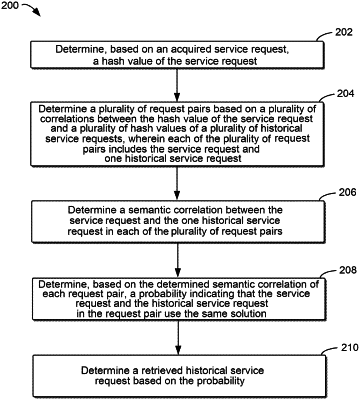| CPC G06F 16/334 (2019.01) [G06F 16/35 (2019.01)] | 20 Claims |

|
1. A method for retrieving service requests, comprising:
determining, based on an acquired service request, a hash value of the service request;
determining a plurality of request pairs based on a plurality of correlations between the hash value of the service request and a plurality of hash values of a plurality of historical service requests, wherein each of the plurality of request pairs comprises the service request and one historical service request, utilizing a filtering operation based on a first indicator in a first stage of a multi-stage similarity modeling process;
determining a semantic correlation between the service request and the one historical service request in each of the plurality of request pairs;
determining, based on the determined semantic correlation of each request pair, a probability indicating that the service request and the historical service request in the request pair use the same solution, to provide a classification result as a second indicator in a second stage of the multi-stage similarity modeling process; and
determining a retrieved historical service request based on the probability;
wherein labels are associated with respective request pairs in conjunction with the multi-stage similarity modeling process, a given one of the labels having one of a first value to indicate that two requests in the corresponding pair use the same solution and a second value different than the first value to indicate that the two requests in the corresponding pair do not use the same solution;
the classification result being generated by a machine learning model trained utilizing at least a portion of the labeled request pairs.
|